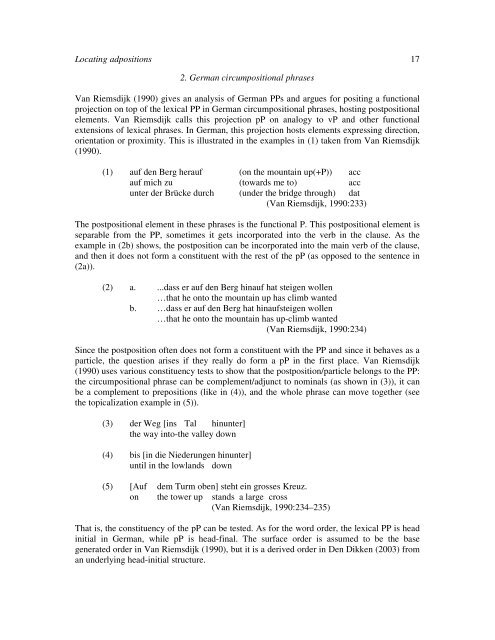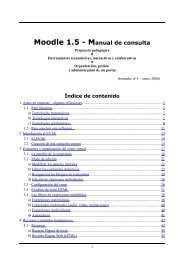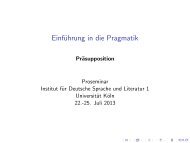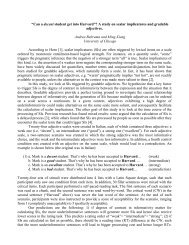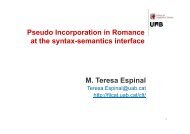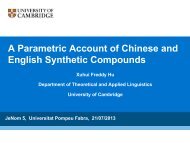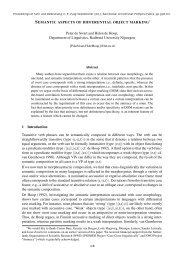Locating adpositions. - corpora@parles.upf
Locating adpositions. - corpora@parles.upf
Locating adpositions. - corpora@parles.upf
Create successful ePaper yourself
Turn your PDF publications into a flip-book with our unique Google optimized e-Paper software.
<strong>Locating</strong> <strong>adpositions</strong> 17<br />
2. German circumpositional phrases<br />
Van Riemsdijk (1990) gives an analysis of German PPs and argues for positing a functional<br />
projection on top of the lexical PP in German circumpositional phrases, hosting postpositional<br />
elements. Van Riemsdijk calls this projection pP on analogy to vP and other functional<br />
extensions of lexical phrases. In German, this projection hosts elements expressing direction,<br />
orientation or proximity. This is illustrated in the examples in (1) taken from Van Riemsdijk<br />
(1990).<br />
(1) auf den Berg herauf (on the mountain up(+P)) acc<br />
auf mich zu (towards me to) acc<br />
unter der Brücke durch (under the bridge through) dat<br />
(Van Riemsdijk, 1990:233)<br />
The postpositional element in these phrases is the functional P. This postpositional element is<br />
separable from the PP, sometimes it gets incorporated into the verb in the clause. As the<br />
example in (2b) shows, the postposition can be incorporated into the main verb of the clause,<br />
and then it does not form a constituent with the rest of the pP (as opposed to the sentence in<br />
(2a)).<br />
(2) a. ...dass er auf den Berg hinauf hat steigen wollen<br />
…that he onto the mountain up has climb wanted<br />
b. …dass er auf den Berg hat hinaufsteigen wollen<br />
…that he onto the mountain has up-climb wanted<br />
(Van Riemsdijk, 1990:234)<br />
Since the postposition often does not form a constituent with the PP and since it behaves as a<br />
particle, the question arises if they really do form a pP in the first place. Van Riemsdijk<br />
(1990) uses various constituency tests to show that the postposition/particle belongs to the PP:<br />
the circumpositional phrase can be complement/adjunct to nominals (as shown in (3)), it can<br />
be a complement to prepositions (like in (4)), and the whole phrase can move together (see<br />
the topicalization example in (5)).<br />
(3) der Weg [ins Tal hinunter]<br />
the way into-the valley down<br />
(4) bis [in die Niederungen hinunter]<br />
until in the lowlands down<br />
(5) [Auf dem Turm oben] steht ein grosses Kreuz.<br />
on the tower up stands a large cross<br />
(Van Riemsdijk, 1990:234–235)<br />
That is, the constituency of the pP can be tested. As for the word order, the lexical PP is head<br />
initial in German, while pP is head-final. The surface order is assumed to be the base<br />
generated order in Van Riemsdijk (1990), but it is a derived order in Den Dikken (2003) from<br />
an underlying head-initial structure.


